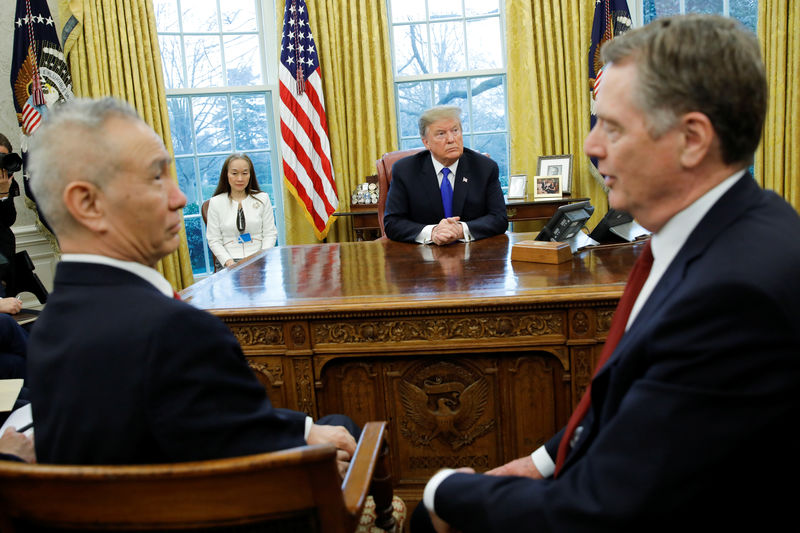 © Reuters. U.S. President Trump meets with China’s Vice Premier Liu He at the White House in Washington
© Reuters. U.S. President Trump meets with China’s Vice Premier Liu He at the White House in WashingtonBy Patturaja Murugaboopathy
(Reuters) – U.S. President Donald Trump said this week he may soon sign a deal with Chinese President Xi Jinping to end a trade war blamed for slowing global economic growth and disrupting markets.
Citing progress in talks between the two countries, Trump said he would delay a planned increase in tariffs to 25 percent from 10 percent on $200 billion of Chinese imports.
China’s trade surplus with the United States, which is at the center of their dispute, rose to $323.32 billion last year, the biggest on record going back to 2006.
Graphic: China’s trade surplus with the United States – https://tmsnrt.rs/2RSj3PM
China’s average import tariff of 3.5 percent is the highest among top industrial nations, data from the World Bank shows, although its tariff rates have fallen sharply over the past 20 years.
Graphic: China and G10 countries average tariff rate – https://tmsnrt.rs/2BT9Hu5
Trump and Xi called a 90-day truce last year to allow time for a deal to be negotiated. But the U.S. threat of tariff increases comes just as China is trying to support its cooling economy, so could offer Trump leverage in the talks.
Negotiators from both camps have been seeking to iron out differences over China’s treatment of state-owned enterprises, subsidies, forced technology transfers and cyber theft.
The two sides are expected to sign memorandums of understanding (MOUs) for actions to be taken by China on issues ranging from structural reforms to trade and economic policies.
Graphic: China’s major exports in 2018 – https://tmsnrt.rs/2U9Qdsf
Graphic: China’s average tariffs – https://tmsnrt.rs/2SXiFwB
Graphic: China’s technology firms’ R&D cost and ROE – https://tmsnrt.rs/2Ez1qgz
Graphic: Major items among $200 billion tariffs – https://tmsnrt.rs/2HGBgfj
Graphic: Major items among $34 billion tariffs – https://tmsnrt.rs/2HG2Rxj
Graphic: Major items among $16 billion tariffs – https://tmsnrt.rs/2HFiipx
Graphic: China’s top imports and exports to U.S. – China’s top imports and exports to U.S.
Reuters reported that both sides were drafting MOUs on cyber theft, intellectual property rights, services, agriculture and non-tariff barriers to trade, including subsidies.
Graphic: US immigrant visas to Chinese residents – https://tmsnrt.rs/2E6CBbx
Trump administration officials have pointed to China’s industrial subsidies, numerous regulations, business licensing procedures, product standards reviews and other practices as non-tariff barriers to trade.
Graphic: U.S. non-tariff barriers – https://tmsnrt.rs/2E5xIze
Graphic: China’s non-tariff measures sector-wise – https://tmsnrt.rs/2TKqtCl
Fusion Media or anyone involved with Fusion Media will not accept any liability for loss or damage as a result of reliance on the information including data, quotes, charts and buy/sell signals contained within this website. Please be fully informed regarding the risks and costs associated with trading the financial markets, it is one of the riskiest investment forms possible.
Source: Investing.com




























